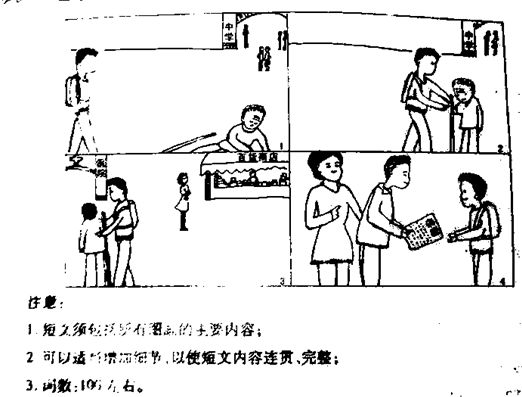8.On a hill 600 feet above the surrounding land,we watch the lines of rain move across the scene,the moon rise over the hills,and the stars appear in the sky.The views invite a long look from a comfortable chair in front of the wooden house.
Every window in our wooden house has a view,and the forest and lakes seldom look the same as the hour before.Each look reminds us where we are.
There is space for our three boys to play outside,to shoot arrows,collect tree seeds,build earth houses and climb trees.
Our kids have learned the names of the trees,and with the names have come familiarity and appreciation.As they tell all who show even a passing interest,maple(楓樹)makes the best fighting sticks and white pines are the best climbing trees.
The air is clean and fresh.The water from the well has a pleasant taste,and it is perhaps the healthiest water our kids will ever drink.Though they have one glass a day of juice and the rest is water,they never say anything against that.
The seasons change just outside the door. We watch the maples turn every shade of yellow and red in the fall and note the poplars'(楊樹)putting out the first green leaves of spring.The rainbow smelt fills the local steam as the ice gradually disappears,and the wood frogs start to sing in pools after being frozen for the winter.A family of birds rules our skies and flies over the lake.
41.What can be learned from Paragraph 2?A
A.The scenes are colorful and changeable.
B.There are many windows in the wooden house.
C.The views remind us that we are in a wooden house.
D.The lakes outside the windows are quite different in color.
42.By mentioning the names of the trees,the author aims to show thatC.
A.the kids like playing in trees
B.the kids are very familiar with trees
C.the kids have learned much knowledge
D.the kids find trees useful learning tools
43.What does the underlined sentence in the last paragraph mean?A
A.The change of seasons is easily felt.
B.The seasons make the scenes change.
C.The weather often changes in the forest.
D.The door is a good position to enjoy changing seasons.
44.What is the main purpose of the author writing the text?D
A.To describe the beauty of the scene around the house.
B.To introduce her children's happy life in the forest.
C.To show that living in the forest is healthful.
D.To share the joy of living in the nature.
分析 本文作者不僅詳細描述了大自然的風景和季節的變化與在大自然中孩子會得到很多知識和快樂,而且還詳盡地描述了作者與家人身居大自然懷抱中切身的美好感受和在此美景懷抱中生活的愜意之情.
解答 41.A 細節理解題.第2段中第一句話"Every window in our wooden house has a view,and the forest and lakes seldom look the same as the hour before."可知:每個窗戶都會有一個不同的風景,森林和湖泊與一小時之前所見到的都不一樣,因此作者身居的環境是多彩和變換的,故答案選A.
42.C 細節理解題.根據第四段話中"Our kids have learned the names of the trees…"與"As they tell all who show even a passing interest,maple(楓樹)makes the best fighting sticks and white pines are the best climbing trees."可知孩子們已經了解了關于周圍環境包括樹在內的很多知識,故答案選C.
43.A 推理判斷題.劃線部分的字面意思為:季節就在門外變化著.再根據本段對于周圍大自然的變化的描述可知,作者身處此地,能夠很容易地感覺到季節的變換,故答案為A.
44.D 推理判斷題.通讀全文,不難了解,作者詳細描述了大自然的風景和季節的變化,感受到在大自然中孩子會得到很多知識和快樂,目的是為了和我們分享這些快樂.故答案為D.
點評 本文作者告訴我們在大自然中孩子會得到很多知識和快樂.本文考查細節題為主,細節題可以在文章中直接找到與答案有關的信息?或是其變體.搜查信息在閱讀中非常重要它包括理解作者在敘述某事時使用的具體事實、數據、圖表等細節信息.在一篇短文里大部分篇幅都屬于這類圍繞主體展開的細節.做這類題一般采用尋讀法?即先讀題,然后帶著問題快速閱讀短文,找出與問題有關的詞語或句子,再對相關部分進行分析對比,找出答案.



